 |
Senenmut |
last update:
17.02.2008
|
Career and Fall (?)
|
Beside his two monuments TT71 and TT353 an extraordinarily number of inscriptions and
other monuments
from Senenmut have survived. Since this is very unusual for a private person, one must draw the conclusions
that first this is due to a coincidental and lucky preservation of his inscriptions and monuments
and second that the numerous statues, figures and inscriptions must have
been produced with the approval - if not even with the promotion - of
Hatshepsut.
|
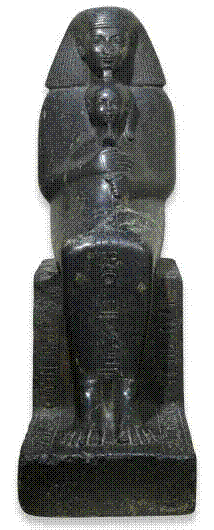
|
Meyer (1982) and - based on her investigations - Dorman (1988) tried to arrange the monuments
of Senenmut in a chronological order. As expected, his career can be
traced by his monuments and especially by his titles mentioned on these monuments
(see also Senenmut's Titles). Among the monuments
that have survived all statues are to be dated into the reign of
Hatshepsut.
The majority of his monuments always included the name of Hatshepsut and
show the full scale of her titles as queen and king (with the only
exception of a statue exhibited in the Egyptian Museum, Cairo, which shows
only the names of Thutmosis III. and of princess Neferu-Ra)
Among the monuments built for Senenmut only four can be dated with
certainty into the time before Hatshepsut took on full royal titles as pharaoh,
since these bear only her titles as "Royal Wife" or as
"God's
wife of Amun" (two seated statues, BM 174 and BM 1513, now exhibited
in the British Museum, London; BM 174 is shown left; a Graffito in Aswan (Sehel) and
the cenotaph of Senenmut at Gebel es-Silsila).
|
| The destroyed inscriptions in his monument, TT71, which
contain text fragments referring to "gaining booty", "Nubia"
and "golden bracelet", possibly give some information about the beginning of
his career. Although Senenmut does not specify anywhere titles which refer to a military function, it is concluded from these fragments that
he accompanied as a young man a - not further specified - king on a campaign
to Nubia and he was extraordinarily successful so that he was rewarded
with aforementioned "golden bracelet". Another inscription on a stele (today
exhibited in the Egyptian Museum, Cairo) also reports on his participation in a
campaign that brought him "rewards of gold". Helck assumes
that this has been a campaign under Amenhotep I.
However, somewhat later Senenmut terminated his military career and changed
to a position in the administration - however, the reasons for this
change are unknown. We also do not know whether it was possible to change
without problems, and if not, who - if necessary - had supported him..
|
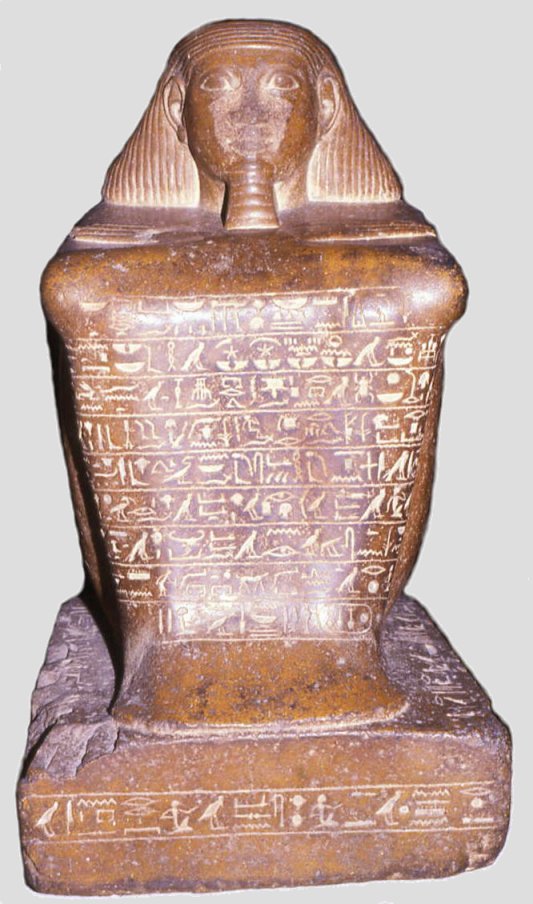
| Above, the block statue of the Senenmut from the British museum
(BM 1513) which is the only one of this type, that represents Senenmut without Neferu-Ra - however
his position as her tutor is mentioned apart from other titles. All
other statues (7 at all), like the block statue exhibited in Berlin or
the one from the Egyptian Museum in Cairo, partly shown below, show him with
together with the princess. |
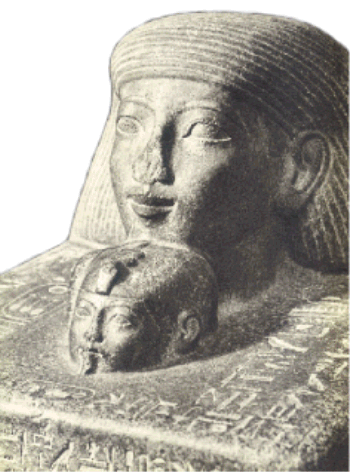
| On one (BM 174) of the two statues exhibited in the British
Museum Senenmut tells that he has been the "chief of the sealers" (jmj-ra
sDAwt). This title is interpreted in that way that he has started
his career with an administrative position in the royal treasury during
the reign of Thutmosis I. |
| In the above mentioned cenotaph at Gebel es
Silsila, he bears two titles - "Steward of the God's Wife" and
"Steward of the King's Daughter".
|
Referring to an earlier analysis
regarding the promotion of officials during the 18. Dynasty done by Helck and with consideration that Neferu-Ra,
who would also be applicable to these titles, is neither named nor
represented here, Meyer (1982) assumes that both titles refer to
Hatshepsut herself. That would mean that the cenotaph has to be dated into the time before
her marriage with Thutmosis II., thus into the reign of Thutmosis I..
Furthermore this would mean that the cenotaph would be the oldest architectural
monument of Senenmut. On the other hand there are no further monuments of Senenmut
from this time - this clearly makes this dating quite improbable.
Meyer assumes that this was an early attempt by Hatshepsut to "legitimate"
herself by emphasizing her descent from Thutmosis I.. Furthermore,
the avoidance of her most important queenly title "King's Wife" (Hmt-nsw), in favor of the
title "Eldest Daughter of the King" (sAt-nsw
tpjt),
indicates the reluctance to associate herself with the reign of her
husband, Thutmosis II.. Therefore, Meyer prefers to date the cenotaph at
Gebel es
Silsila into the years of her regency. In any case the cenotaph seems to be the oldest documentation for the relationship
between Senenmut and Hatshepsut. |
Dorman (1988) also rejects the dating of the cenotaph
into the reign of Thutmosis I. and he points to the fact that in the
cenotaph a male ruler in full garb and attitude is shown twice. However,
the accompanying inscriptions refer to a female gender of the
represented person - who can be only Hatshepsut. Since a such
representation could not have been carved during the reigns of her
father or her husband, Dorman dates the cenotaph into the early years of
the reign of Hatshepsut/Thutmosis III.
|
 |
During the times of the "Great Royal Wife" Hatshepsut he further collected
(her) confidence and titles, so he became the "Overseer of the large
Hall" - with which probably means the audience hall - and the "Overseer
of the two Granaries of Amun". At this time the title of the "Overseer
of the two Granaries of Amun". was economically the most important office in the temple of the
Amun -now he was one of the most important men of "The Two
Lands". The great confidence of Hatshepsut - and certainly also of Thutmosis II. -
is testified by his position as a tutor of the "King's Daughter" Neferu-Ra. Numerous
"tutor statues" (like the one shown above, the left one or that on the start page
"Senenmut") show him together with the
princess who is carefully put in his arms or his coat.
The tutor statue shown left is exhibited today in Chicago.
|
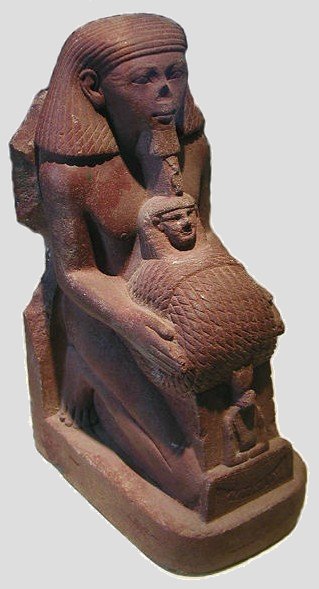
|
During the time of the regency he ascended to the "Great
Stewardship of the Property" (jmj-ra pr wr n
Hmt-nTr) of Hatshepsut and of Neferu-Ra. After Hatshepsut finally
had taken the kingship, his power was increased further by additional offices, because
he received among others the office of the "Stewardship of the
Property of Amun". Thus, he had the responsibility for the entire possession of the temple
of Amun in Karnak and all attached temples, with all of their precious metals and jewels,
fields, herds of cattle, and other business. In this office he was also responsible for numerous building activities of
Hatshepsut (the left statue which is today in the Louvre, E 11057, shows Senenmut
with a measuring rope; according to Dorman, 1988, the statue had been restored
due devastation during the Amarna-period. During the restoration which most
likely took place in Ramesside times the small human face had been introduced,
therefore, this is not a representation of Neferu-Ra), e.g. for the manufacturing and erection the two obelisks in the temple of Amun
at Karnak, for work at Djeser djeseru and among others also for work at the temple of Armant (see historical data to Senenmut). Whether
he had the necessary abilities of an architect, we do not know. But without doubt
his power would certainly have permitted him to select convenient architects. This
would also explain also the use of the same "unit of measure" in the
tomb of Hatshepsut (KV20) and in her temple at Deir el-Bahari, Djeser djeseru,
what made Romer (quoted after: Reeves, N., Wilkinson, R. H., "The valley of the kings") to assume
that Senenmut had been the architect in both cases.
|
| Beside the offices mentioned above, which he surely
executed, he also got numerous "courtly titles" - like the one
called "Only friend of the Pharao". These titles most likely
testify the extraordinary confidence of Hatshepsut and the authorization
to access to her private rooms. However, it is hard to image that such titles were connected with
personal services, e.g. the title of a "Great Overseer of the Bathroom" or that
one of the "Great Overseer of the Royal Bedroom".
Of course Senenmut - as a trusted friend and naturally also as an owner of numerous important offices -
has been a councilor of Pharao and a member of the advisory board
at the royal court - in this function he is shown on a relief at Djeser djeseru
when the royal court decided about the expedition to Punt. |
Concerning the End of Senenmut there are more speculations than facts. At least until
regnal year 16 of Hatshepsut/Thutmosis III. he held his office(s). Apparently
thereafter, his tracks are lost. His unfinished monument, TT353, was
closed, some his figures therein - and also in TT71 - were destroyed.
There is no information that he had been buried in one of his tombs.
The usual speculations regarding his end are that he had suddenly
fall from royal favor whereby several different "reasons"
are raised to support these speculations.
|
| In the first version it is told that his has "incurred the displeasure
of Hatshepsut" because he built a tomb of almost royal extents, TT353, which
ended up below Djeser djeseru. Beyond that he had presumed - of course "secretly" again
- to hide his own image and accompanying inscriptions behind the door
wings of Djeser djeseru.
|
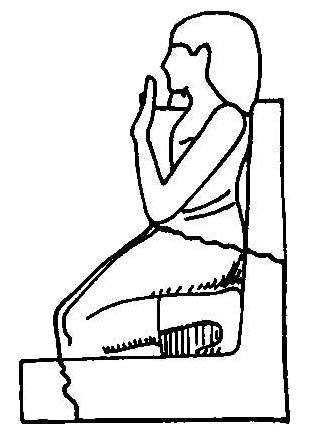 |
Altogether, the temple of Hatshepsut had about 60 doorways each
of which was provided with a wooden door or a pair of doors. The larger
number of these doors opened inward in such a way that parts of the
doorframe were concealed. On almost every of these normally hidden
surfaces Senenmut was shown as a small figure standing or kneeling (as
shown in the left drawing; Hayes 1957) in
the act of "giving praise to Amun (or Hathor)". Up to 66
of the panels have been identified so far, they have been found
throughout the whole temple. However, they do not appear in smaller
niches because these either had no doors or the doors opened outward.
Furthermore, the panels are absent in four small chambers opening off
the north portico of the middle courts - most likely, these chambers
were not finished at the time Senenmut has fallen from grace. Only on a
few side-walls of some niches of the Chapel of Hathor pictures of
Senenmut have been survived. |
|
Especially the fact that Senenmut had placed his figures where there
was little likelihood of their being seen was a strong argument in
believing that this was done "secretly).
|
|
Thus, it was speculated that "as a consequence of ignoring royal
privileges Hatshepsut got rid of him". However, it is hard to believe that
he could have attached his small figures at more than 60 of the doors
at Djeser djeseru without agreement by Hatshepsut and particularly without discovery.
|
| Furthermore, this version is contradicted by two rather late discovered and strongly destroyed inscriptions
found on both sides of the door in the northwest Hall of Offerings at Djeser
djeseru (published by Hayes, 1957). On a surface of about 165 x 46 cm Senenmut who is shown in
adoration is accompanied by inscriptions each consisting of 5 registers.
Beside a list of various titles these inscriptions recounted the permission
of Hatshepsut herself to allow him to place his picture and name among the
entourage of Pharao at all doors or doorways not only at Djeser djeseru
but in all other temples of the gods of upper und lower Egypt as well and
to be honored thereby.
|
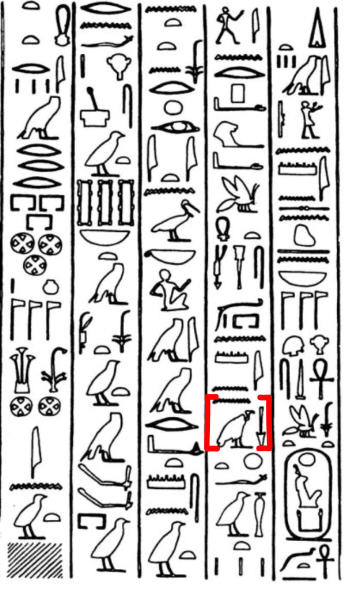 |
1. Register:
Giving praise to Amun and
smelling the ground to the Lord of the Gods on behalf of the life,
prosperity, and health of the King of Upper and Lower Egypt, Maat-ka-Ra,
may she live forever,2. Register:
by the Hereditary Prince (r-pat)
and Count (HAtj-a), the Treasurer of
the King of Lower Egypt (sDAwtj-bjtj),
the Sole Companion (smr-watj), the
Steward of Amun (mr pr
jmn), Senenmut
(name in red brackets), in accordance with a favor
3. Register:
of the king's bounty, which was extended to this
servant in letting
4. Register:
his name be established on every wall, in the
following of the king, in +sr
Dsrw
5. Register:
and likewise in the temples of the gods of Upper and
Lower Egypt. Thus spoke (the king). |
| Above text and translation of the permission discovered
at Djeser djeseru (Hayes, 1957). The inscription recounts also that he
is allowed to place his image in other temples - however, as known so far none
has been found outside Djeser djeseru. |
The 2nd version connects his "End" with an "assumed
early death" of Neferu-Ra. Neferu-Ra does not appear anymore in TT353, thus, it
was assumed that she probably
died before or in year 16. In the consequence of her death Senenmut
should has lost his influence or his powerful position - that opened
Hatshepsut the opportunity to get rid of a companion who has served her
a very long time but was not needed anymore.
Again, there are no corroborating findings, on the contrary he seems to have
reached the highest point of his career in the year 16.
Furthermore, recarved inscriptions
on stelae suggest that Neferu-Ra has lived as the principle queen of
Thutmosis III until his 22. or 23. regnal year. |
| The third version also assume an early death of Neferu-Ra.
Here it was speculated that - after the death of Neferu-Ra
- Senenmut has switched his political support from Hatshepsut to the
future king, Thutmosis III. With the death of Neferu-Ra, "God's Wife of
Amun" and designated "Great Royal Wife" of the next king,
Thutmosis III., he saw his own influence on the future policy shrinking.
Hatshepsut, annoyed about this "betrayal", thereupon got rid of
him. |
| The findings at his monuments do not contradict
the interpretation that their destruction probably could have been
initiated by Hatshepsut or were at least done with her knowledge.
However, as in all other cases the findings are not clear and thus open
for further interpretation. |
| Perhaps the explanation for the disappearing of Senenmut after year
16 is relatively simple. If he already participated in campaigns during
the reign of Amenhotep I. and started his administrative career under Thutmosis I., then
he must have reached an age of 50 to 70 years in regnal year 16. Therefore,
it is quite convincing that he retired due to his age and died between the years 16 and 19,
thus some years before Hatshepsut deceased. That TT353 was not finished - in time before
his death -, does not naturally exclude that he had been buried in TT71,
that most likely was ready at least for a subsidiary burial - there at least a sarcophagus
has been found, although no mummy. |
|






